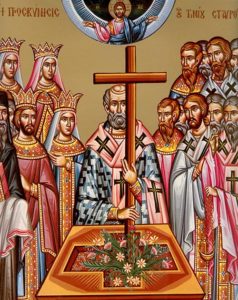
The Third Sunday of Lent is the Veneration of the Cross.
Click here for the text of Vespers, Orthros, and the Divine Liturgy variables.
Click here for the Typica service. (When reading Typica instead of attending Liturgy, you will need both the Typica and Divine Liturgy texts.)
Lenten Sunday Vespers is here.
Theme
The commemoration and ceremonies of the Third Sunday of Lent are closely parallel to the feasts of the Veneration of the Cross (September 14) and the Procession of the Cross (August 1). Not only does the Sunday of the Holy Cross prepare us for commemoration of the Crucifixion, but it also reminds us that the whole of Lent is a period when we are crucified with Christ.
Observance of the Week
At the conclusion of the Matins (the traditional practice in association with a vigil) or of the Divine Liturgy, a special service is held. The Cross is placed on a tray surrounded by basil or daffodils and is taken in solemn procession through the church to the chanting of the Thrice Holy Hymn. The tray is placed on a table before the people, and the hymn of the Feast of the Cross is chanted. As the priest venerates the Cross, the priest then the people chant, “We venerate Your Cross, O Christ, and Your holy Resurrection we glorify.” At the conclusion of the service, the people come and venerate the cross and receive the flowers or basil from the priest.
Story
Every hard and strenuous work is accomplished with great difficulty, which appears especially in the middle of such work; for the effort in this performance brings with it fatigue which makes the accomplishment of the rest difficult. Having arrived with God’s grace at the middle of the Fast, our compassionate Mother—the Holy Orthodox Church—thought fit to reveal to us the Holy Cross as the joy of the world and power of the faithful to help us carry on the struggles of the divine Fast.
By its power, O Christ God, preserve us from the crafty designs of the evil one and account us worthy to worship Thy divine Passion and life-giving Resurrection, as we achieve the course of the Forty Days with ease, and have mercy on us, as Thou alone art good and the Lover of mankind. Amen
The Icon
The most common icon associated with the Veneration of the Cross is the same icon used on the Feast of the Universal Exaltation of the Precious and Life-Giving Cross, September 14. In the icon, Patriarch Macarius is standing in the pulpit elevating the Cross for all to see and venerate. On each side of the Patriarch are deacons holding candles. The elevated Cross is surrounded and venerated by many clergy and lay people, including Saint Helen, the mother of Emperor Constantine.
In the background of the icon is a domed structure that represents the Church of the Resurrection in Jerusalem. This church was one of the churches constructed and dedicated by Emperor Constantine on the holy sites of Jerusalem.
Hi I am new to the Church and was far too embarrassed to ask anyone.
In reference to “As the priest venerates the Cross, the priest then the people chant, “We venerate Your Cross, O Christ, and Your holy Resurrection we glorify.” At the conclusion of the service, the people come and venerate the cross and receive the flowers or basil from the priest”
What is traditionally done with the basil given to us? I have tried looking it up everywhere and still haven’t found a thing
Hi there! Great question! Any blessed items given out at church- blessed bread, basil, bay leaves, palms, flowers- are blessed, and therefore should be treated with a certain degree of respect. Blessed bread should be eaten. Basil or bay leaves can go into your cooking fresh or dried and used later. Palms and flowers can be placed on your altar. Eventually, they should make their way to the burn box at church, or if you compost, that’s fine too. They don’t belong in the trash, though.